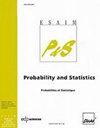一维鞅重排耦合
IF 0.7
4区 数学
Q4 STATISTICS & PROBABILITY
引用次数: 3
摘要
我们对鞅重排耦合感兴趣。正如Wiesel为了证明鞅最优输运问题的稳定性所引入的,这些是实线上凸阶的两个概率测度之间耦合的自适应wasserstein距离在这两个边际之间的鞅耦合集上的投影。在原始耦合的质心色散假设下,特别是在hoeffding - fr本文章由计算机程序翻译,如有差异,请以英文原文为准。
One dimensional martingale rearrangement couplings
We are interested in martingale rearrangement couplings. As introduced by Wiesel in order to prove the stability of Martingale Optimal Transport problems, these are projections in adapted
Wasserstein distance of couplings between two probability measures on the real line in the convex order onto the set of martingale couplings between these two marginals. Under a barycentre dispersion assumption on the original coupling which is in particular satisfied by the Hoeffding-Fréchet or comonotone coupling, Wiesel gives a clear algorithmic construction of a martingale rearrangement when the marginals are finitely supported and then gets rid of the finite support assumption by relying on a rather messy limiting procedure to overcome the lack of relative compactness. Here, we give a direct general construction of a martingale rearrangement coupling under the barycentre dispersion assumption. This martingale rearrangement is obtained from the original coupling by an approach similar to the construction we gave in [25] of the inverse transform martingale coupling, a member of a family of martingale couplings close to the Hoeffding-Fréchet coupling, but for a slightly different injection in the set of extended couplings introduced by Beiglböck and Juillet and which involve the uniform distribution on [0,1] in addition to the two marginals.
求助全文
通过发布文献求助,成功后即可免费获取论文全文。
去求助
来源期刊

Esaim-Probability and Statistics
STATISTICS & PROBABILITY-
CiteScore
1.00
自引率
0.00%
发文量
14
审稿时长
>12 weeks
期刊介绍:
The journal publishes original research and survey papers in the area of Probability and Statistics. It covers theoretical and practical aspects, in any field of these domains.
Of particular interest are methodological developments with application in other scientific areas, for example Biology and Genetics, Information Theory, Finance, Bioinformatics, Random structures and Random graphs, Econometrics, Physics.
Long papers are very welcome.
Indeed, we intend to develop the journal in the direction of applications and to open it to various fields where random mathematical modelling is important. In particular we will call (survey) papers in these areas, in order to make the random community aware of important problems of both theoretical and practical interest. We all know that many recent fascinating developments in Probability and Statistics are coming from "the outside" and we think that ESAIM: P&S should be a good entry point for such exchanges. Of course this does not mean that the journal will be only devoted to practical aspects.
 求助内容:
求助内容: 应助结果提醒方式:
应助结果提醒方式:


